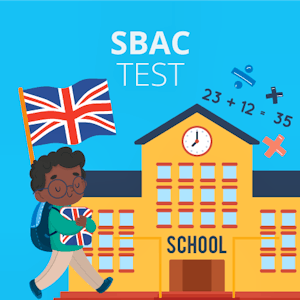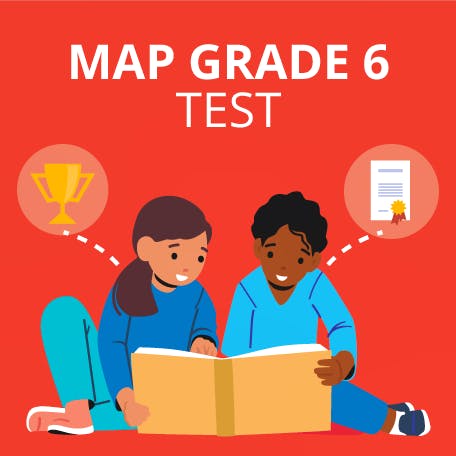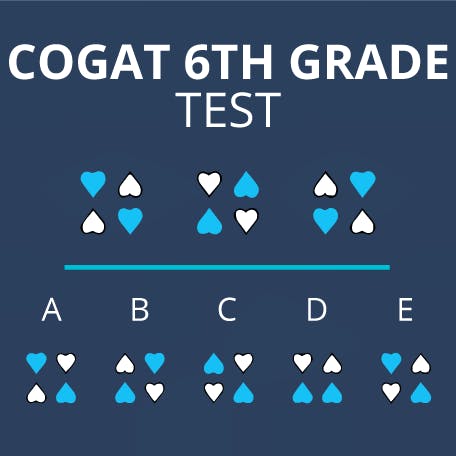How to Prepare For The Smarter Balanced Test (SBAC) – A Detailed 2025 Study Guide with Practice Questions
Updated November 18, 2023

- What Is the SBAC Test?
- When Is the SBAC Test Administered?
- What Is the SBAC Test Format?
empty
empty
- SBAC Practice Test Questions
empty
empty
empty
empty
empty
empty
empty
empty
- Understanding SBAC Assessment Scores
empty
empty
- How to Prepare for the SBAC Assessment
- Frequently Asked Questions
- Final Thoughts

The Smarter Balanced Assessment Consortium Test, known as the SBAC test, is a standardized assessment of English and math used by schools in participating states.
Administered to students in grades K to 12, it measures grade level proficiency and academic progress through computer-adaptive testing and performance tasks.
The Smarter Balanced Test is an educational tool developed and administered by the Smarter Balanced Assessment Consortium (SBAC), hence the abbreviation SBAC test.
In this article we explore what the test involves, what the results mean and how to help a student prepare for their SBAC assessment.
What Is the SBAC Test?
The SBAC assessment is a set of standardized tests that evaluate how well students are performing in the subjects of English Language Arts (ELA) and mathematics.
These assessments are taken by students ranging from elementary school to high school in multiple states across the US.
The tests are developed and managed by the Smarter Balanced Assessment Consortium (SBAC), a collaborative group of states working together.
Its goal is to create consistent assessments that align with the Common Core State Standards, which serve as shared educational objectives for students throughout the country.
The SBAC assessment is designed to measure critical thinking, problem-solving skills and the practical application of knowledge.
Essentially, it aims to measure how effectively students can apply what they've learned in real-life situations.
The results of the SBAC test provide insights into a student's academic progress and readiness for the next steps in their education journey.
These insights guide teachers in tailoring their instruction to suit each student's strengths and areas needing improvement.
By understanding individual needs, students can receive more effective support to succeed academically.
When Is the SBAC Test Administered?
The SBAC test is administered to students across various grade levels, with assessments tailored to the specific needs and abilities of each group:
-
Elementary school (grades three to five) – At this level the SBAC test is designed to measure foundational skills and concepts. Performing well on these assessments can indicate a strong academic foundation.
-
Middle school (grades six to eight) – Here the SBAC test becomes more challenging, reflecting the advanced skills and knowledge expected at this stage. Success on these assessments is not only a measure of current proficiency but also an indicator of preparedness for high school-level coursework.
-
High school (grades nine to 12) – Results at this level can have significant implications for a student's academic journey. Exceptional performance may make students eligible for accelerated programs, such as advanced placement (AP) courses or early college enrollment.
The SBAC test is also administered in different versions:
-
Interim SBAC assessment – Administered periodically throughout the school year, these help teachers gauge student progress and adjust instruction as needed.
-
Summative SBAC assessment – Administered annually, usually at the end of the academic year, these provide a comprehensive measure of a student's proficiency in ELA and mathematics, serving as a snapshot of their overall performance.
The rest of this article focuses specifically on the summative SBAC assessment.
What Is the SBAC Test Format?
The SBAC test format has two components – a computer-adaptive testing (CAT) section and a performance task (PT).
These components are common to both the mathematics and ELA assessments.
Computer-Adaptive Testing (CAT)
In the CAT section, students encounter a series of adaptive questions.
If a student answers a question correctly, the subsequent question may become more challenging, and vice versa.
This adaptiveness tailors the test to the individual student's abilities, providing a more precise measurement of their skills.
-
SBAC math – For the SBAC math test, CAT questions cover a wide range of topics relevant to grade level including algebra, geometry, statistics and data analysis. These questions may include multiple-choice, short answer or extended response items.
-
SBAC ELA – In the ELA assessment, CAT questions assess reading comprehension, vocabulary and language usage. Students may encounter multiple-choice questions related to reading passages, short answer items asking for written responses and questions assessing writing conventions.
The CAT section is not strictly timed, allowing students to work at their own pace within a designated testing window.
The duration varies based on the grade level and assessment type but typically ranges from 45 minutes to an hour for each subject.
Performance Tasks (PT)
Performance tasks challenge students to apply their knowledge and skills to real-world scenarios or complex problems.
These tasks mirror the challenges students may face in their future education and careers.
-
SBAC math – In the math PT section, students may encounter multistep problems that require them to analyze data, solve practical math problems or demonstrate mathematical reasoning. They must provide explanations and evidence to support their answers.
-
SBAC ELA – ELA performance tasks typically involve reading and analyzing texts, conducting research and producing written responses, such as essays or reports. Students must demonstrate their ability to synthesize information and communicate effectively.
The PT section requires more time than the CAT section. It can take up to several hours to complete, depending on the grade level and complexity of the tasks.
SBAC Practice Test Questions
Below you’ll find a selection of SBAC questions for both math and ELA at different grade levels.
SBAC Math Practice Test Question: Grade Three
Mia has 5 red marbles and 3 blue marbles. If she puts all the marbles into a bag and randomly selects one, what is the probability that she will choose a red marble?
a) 1/2
b) 2/3
c) 5/8
d) 3/5
Samantha is planning a rectangular garden that is 8 feet long and 6 feet wide. What is the total area of the garden in square feet?
a) 12 square feet
b) 48 square feet
c) 54 square feet
d) 56 square feet
Solve for x:
a)
b)
c)
d)
Simplify the expression:
a)
b)
c)
d)

Read the following sentence:
The bright sun shines in the sky.
Which word in this sentence is an adjective?
a) The
b) Sun
c) Bright
d) Sky
Which of the following sentences uses a simile?
a) The river flowed gently through the valley.
b) She sang a beautiful song.
c) The moon was like a silver coin in the night sky.
d) The dog barked loudly.
Read the following excerpt from a novel:
The old, mysterious mansion stood tall against the backdrop of the dark, eerie forest. Its windows, long abandoned, stared out like vacant eyes into the night. The wind whispered secrets through the trees, adding to the eerie atmosphere.
What is the mood or atmosphere created in this excerpt?
a) Joyful
b) Mysterious
c) Humorous
d) Exciting
Which literary device is used in the following line from the poem?
The waves danced playfully along the shore
a) Alliteration
b) Metaphor
c) Irony
d) Personification
Understanding SBAC Assessment Scores
On completion of their SBAC assessment, each student is assigned two scores – a scaled score and an achievement level score.
Scaled Scores
A scaled score is a numerical representation of a student's overall performance.
These scores appear on a scale ranging from around 2,000 to 3,000, with higher scores indicating better performance.
Scaled scores are valuable for assessing a student's current level of achievement and monitoring their progress over time.
Achievement Level Scores
Using their scaled scores, students are placed into achievement level categories, ranging from level one to level four.
Each state that uses the SBAC test has its own way to describe these levels.
For example, California uses exceeded, met, nearly met or not met expectations.
Nevada on the other hand uses minimal understanding, partial understanding, proficient and advanced to describe achievement levels.
However they are described, achievement levels three and four indicate a student is on track or ahead of grade level expectations.
How to Prepare for the SBAC Assessment
Step 1. Explore the SBAC Test Format
A good understanding of the SBAC test format can help alleviate test anxiety and build confidence, so sit down with your child to explore the components of the test looking at both computer-adaptive testing and performance tasks.
Discuss what each component entails and address any questions or concerns your child may have.
Step 2. Review and Revise Content Areas
Work with your child to review and revise content areas aligned with their grade level and to identify specific topics and concepts in mathematics and ELA that need attention.
Consider setting up a study schedule that includes regular review sessions. Be available to explain difficult concepts and offer guidance on effective study techniques.
Step 3. Study Sample SBAC Questions
Encourage your child to actively engage with sample SBAC questions. These resources are readily available and a great way to build familiarity with the test format.
Work together to solve these sample questions, discussing strategies for approaching different question types.
Step 4. Improve Critical Thinking Skills
Critical thinking skills play a significant role in the SBAC assessment, so engage in discussions and activities that promote problem-solving and analytical thinking.
Encourage your child to read challenging texts, analyze complex problems and provide evidence-based explanations.
This will not only help them in the test but also in their overall academic growth.
Step 5. Take SBAC Practice Tests
Ensure your child takes full advantage of SBAC practice tests. These mock assessments help them understand exactly what they’ll face on test day and develop effective test-taking strategies.
Set aside specific times for your child to complete practice tests and review their responses together, emphasizing both correct answers and areas for improvement.
Step 6. Prepare Physically and Mentally
It’s important to focus on physical and mental well-being during the preparation phase and on test day.
Encourage your child to establish a healthy routine by getting enough sleep and maintaining a balanced diet.
Prioritize relaxation techniques, such as deep breathing or mindfulness exercises, and create a calming atmosphere at home.
The Smarter Balanced Assessment Consortium (SBAC) test is an assessment program designed to measure proficiency in English Language Arts/Literacy (ELA) and mathematics.
It’s used in K to 12 education to evaluate students' knowledge and skills in alignment with the Common Core State Standards.
SBAC test results give teachers a good indication of a student's progress over time and help inform instructional strategies.
The SBAC test is a standardized assessment of English and math skills used by schools in several US states.
There are two test sections for each subject area.
The SBAC test is not a tool for determining academic grades.
Its primary function is to assess competence in English Language Arts/Literacy and Mathematics, with the aim of providing educators with valuable data to inform their teaching methods and gauge academic progress accurately.
Typically, schools respond by providing additional support and engaging in communication with parents to collaborate on an improvement plan.
Some students may have the opportunity to retake the test for a second chance at demonstrating proficiency.
In all cases, the test provides valuable feedback on their proficiency in core subjects, helping identify areas where they may need extra support or improvement.
However, the test's direct impact on students, such as affecting grade promotion, depends on their school or district's policies.
So, whether the SBAC truly matters to students depends on how it's used in their specific educational context.
SBAC test results are not usually considered as part of a student’s college application.
These standardized tests are more relevant for K to 12 assessment and education and are generally not factored into the college admissions process.
The test is designed to align with relevant expectations for different grade levels, so the test’s complexity increases as a student advances through education.
While some students may find it challenging, others may find it manageable with adequate preparation and support from educators.
Final Thoughts
As a measure of proficiency in math and English, the SBAC test serves as a tool to gauge academic progress and readiness for future educational milestones.
Preparation for the SBAC assessment is essential as it not only ensures familiarity with the test format but also helps students demonstrate their full potential.
A well-prepared student can showcase their knowledge and skills more effectively, leading to accurate results that inform instruction and support their academic journey.
So, by actively engaging in SBAC test preparation, students are better equipped to excel academically and achieve their educational goals.













